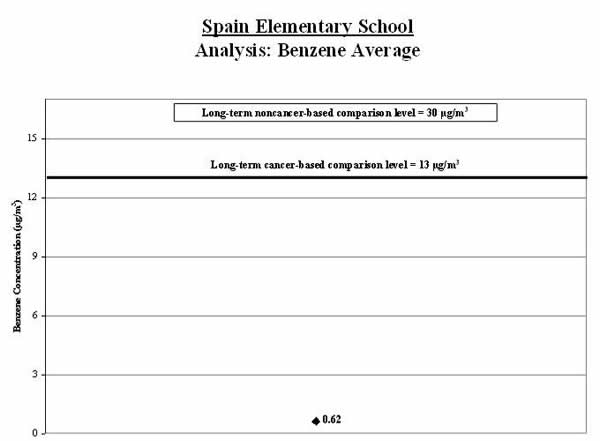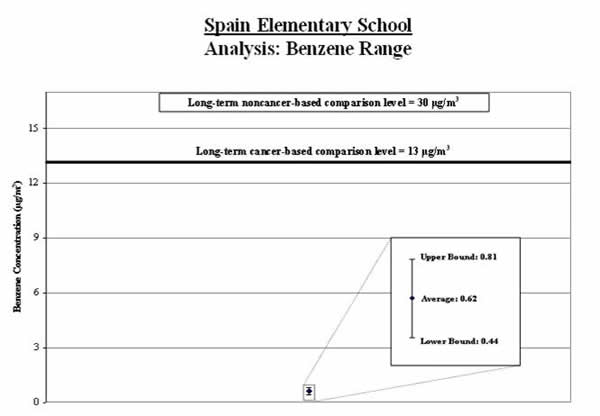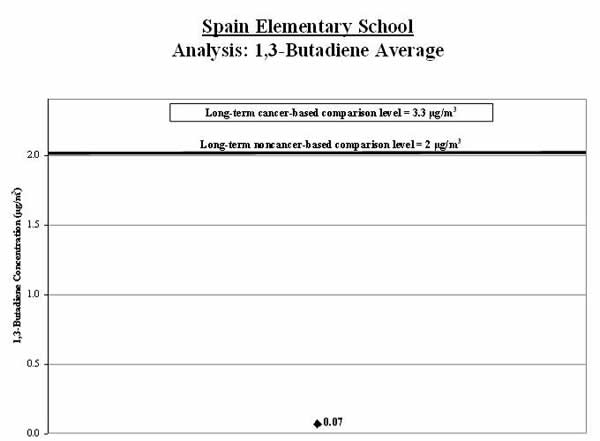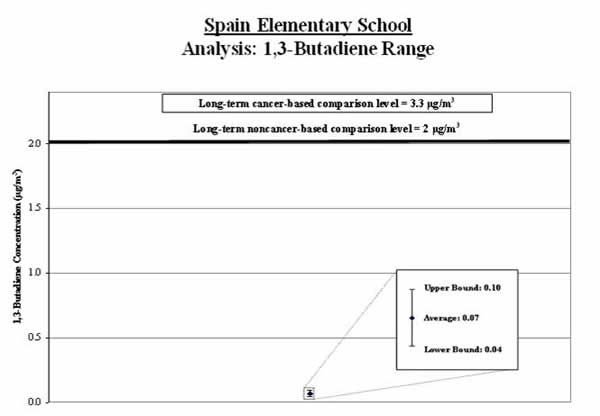Assessing Outdoor Air Near Schools
Spain Elementary School - Detroit, MI
Results and Analysis of EPA’s monitoring
EPA selected this school for monitoring because it is located near major roadways which are a source of air toxics emissions. Computer models were used to determine which air toxics may be present at elevated levels in the outdoor air near the school. These models showed that benzene and 1,3-butadiene could be present in the air around the school due to the presence of mobile sources such as cars and other motor vehicles and off-road machinery which prompted EPA to test to see if the levels present may be of concern.
| Primary Findings | Levels of benzene and 1,3-butadiene in the air at the school were not as high as was suggested by the modeling information available prior to monitoring and are below the levels of concern that had been suggested by the modeling information available prior to sampling. However, these results indicate the influence of mobile source pollutants of concern that are the focus of EPA actions nationwide. |
| Key Pollutants Monitored | Benzene. Inhalation of benzene at high levels can affect the bone marrow and can cause anemia and leukemia. 1,3-Butadiene. Inhalation may affect the reproductive system if people are exposed to high levels. |
| Next Steps | EPA will not extend air toxics monitoring at Spain Elementary School at this time. However, EPA remains concerned about mobile source emissions and continues to work to reduce those emissions across the country, through national rules and by providing information and suggestions to assist with reductions in local areas. The Michigan Department of Natural Resources and Environment (DNRE) will continue to implement reductions in mobile source emissions through implementation of national programs and its own mobile source programs and initiatives. More information on air quality monitoring in southeast Michigan for the Detroit area is at: http://www.deqmiair.org/index.cfm?detroit=1. |
Summary of Study Approach and Findings
Approach:
- A monitor collected air samples from August 17, 2009 through October 28, 2009 at Spain Elementary School in Detroit, MI.
- We posted individual air sample results on this website throughout the monitoring period to keep your community informed during the monitoring period.
- During the monitoring period, we evaluated the monitored concentrations to see if there was a concern from short-term exposures (e.g., several weeks).
- When the monitoring was complete, we analyzed the results to see if there was a concern from long-term exposures (over a lifetime).
- Also, when the monitoring was complete, we evaluated all the air samples from the on-site monitor. We also evaluated information on wind speed and wind direction from a weather monitor at the school, along with historical weather information and information about nearby mobile sources of benzene and 1,3-butadiene emissions.
Findings:
- Measured levels of benzene and 1,3-butadiene and associated longer-term concentration estimates were not as high as was suggested by modeling information. Although they were below the levels of significant concern suggested by modeling, these results do indicate the influence of mobile source pollutants of concern.
- Benzene and 1,3-butadiene are common in the outdoor air in urban areas where many sources are located near one another, particularly mobile sources such as cars and other motor vehicles and off-road machinery. Levels of benzene and 1,3-butadiene in many urban areas, such as Detroit, can be elevated. EPA remains concerned about mobile source emissions and continues to work to reduce those emissions across the country, through national rules and by providing information and suggestions to assist with reductions in local areas.
- The process to identify schools for monitoring relied on emissions estimates and other information. Ambient air monitoring at the school allowed measurement of what was actually in the air.
- The most recently available benzene and 1,3-butadiene emissions estimates for the nearby facility from the 2005 National-Scale Air Toxics Assessment (NATA) are lower than the estimates used to identify this school for monitoring.
- Based on the analysis described here, EPA will not extend air toxics monitoring at this school. However, EPA’s ongoing research and national air toxics monitoring programs (e.g., the National Air Toxics Trends Stations, such as the one in Detroit, MI) will continue to collect information on mobile source impacts on outdoor air nationally.
- Click here for additional information
How We Analyzed the Information We Collected at this School
The analysis considered whether the information collected at the school might raise concerns for the health of children or adults at the school. We looked at the following types of information:
- Measured benzene and 1,3-butadiene concentrations and information on benzene and 1,3-butadiene
- Measured wind direction and wind speed at the school
- Information about nearby sources of benzene and 1,3-butadiene emissions
Analysis of Measured Benzene Concentrations:
1. Calculate the average: We calculated the average of the benzene measurements (shown by the black diamond in the graph below). We compared this average to the long-term comparison level (thick line on the graph below).
Result: The average benzene level for the samples collected was below the long-term comparison level.

2. Calculate a range: To account for varying air concentrations of benzene, we calculated a range around the average. We did this by estimating high and low values that the longer-term concentrations might reach using common statistical tools. We compared the highest point in the range (called the “upper bound”) to the long-term comparison level.
Result: The high end of the range is lower than the comparison level.

Analysis of Measured 1,3-Butadiene Concentrations:
1. Calculate the average: We calculated the average of the 1,3-butadiene measurements (shown by the black diamond in the graph below). We compared this average to the comparison level (thick line on the graph below).
Result: The average 1,3-butadiene level for the samples collected was below the comparison level.

2. Calculate a range: To account for varying air concentrations of 1,3-butadiene, we calculated a range around the average. We did this by estimating high and low values that the longer-term concentrations might reach using common statistical tools. We compared the highest point in the range (called the “upper bound”) to the comparison level.
Result: The high end of the range is lower than the comparison level.

Analysis of Measured Wind Direction and Wind Speed at the School
We took measurements of wind direction and speed every day during the sample period. We took special note of the wind speed and direction on the days we took measurements of benzene and 1,3-butadiene.
| What we looked at | What we found |
| We looked at whether the wind data taken on the days we took measurements of benzene and 1,3-butadiene are similar or different from the wind patterns during the entire sampling period. | We found the wind patterns taken on the days we took measurements of benzene and 1,3-butadiene to be similar to those observed during the entire sampling period. |
| We looked at whether the wind pattern during the sampling period is reflective of regional wind pattern over the long term. | Although we lack long-term wind data at the monitoring station, the wind patterns at the NWS site during the sampling period are generally similar to the historical long-term wind flow pattern at that location. This suggests that, on a regional scale, the 3‑month sampling period is representative of year-round wind patterns. |
Analysis of Information on Nearby Source of Benzene and 1,3-Butadiene Emissions
| What we looked at | What we found |
| Whether we could determine if mobile source activity was typical during the sampling period | There were no disruptions in typical roadway activity during the sampling period. |
| The concentrations of benzene and 1,3-butadiene measured at the school are lower than those suggested by the information that helped identify this school for monitoring. | |
| EPA’s ongoing research and national air toxics monitoring programs will continue to collect information on mobile source impacts on outdoor air nationally. | |
| MDNRE will continue to implement reductions in mobile source emissions through implementation of national programs and its own mobile source programs and initiatives. More information on air quality monitoring in southeast Michigan for the Detroit area is at: http://www.deqmiair.org/index.cfm?detroit=1. |
Additional Information
Technical Report for School: Assessing Outdoor Air Near Schools: Spain Elementary School (Detroit, MI) (PDF) (30pp, 866k). The technical report is geared toward risk assessors, risk managers, and other regulatory agencies.
Background on School Monitoring Effort
